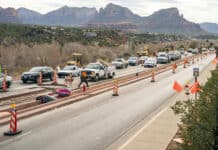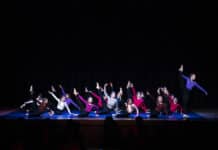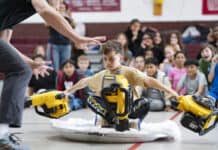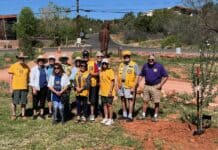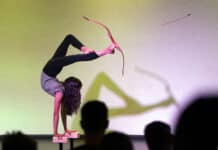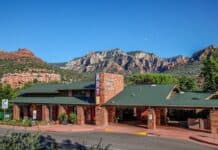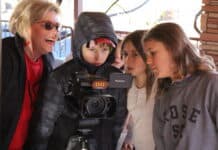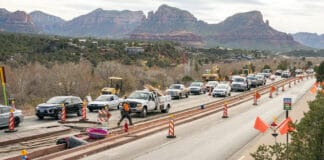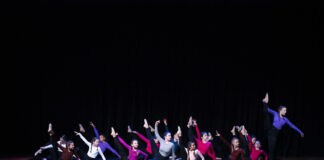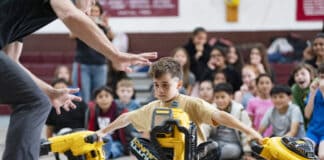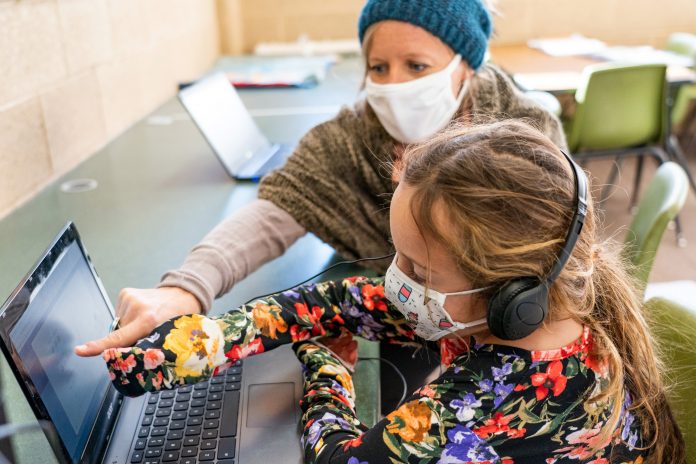
Upon entering the lower elementary school at Sedona Charter School, one might not know that COVID-19 was even a concern. Besides the students’ tiny masks — with prints ranging from hearts, moustaches, spider webs, rainbows, camouflage, ice cream cones and bear muzzles — the 2,000-square-foot classroom looks pretty similar to the way it always has.
But the teachers know just how much the classroom and school have changed in the last 10 months.
In a normal year, the lower elementary school classroom — for grades one, two and three — has a 60-student capacity with four teachers. This year, there are 37 students enrolled — the exact number of students that a general contractor determined would be able to fit in the classroom with six feet of spacing between them. Of the 37 students enrolled, 21 came back to the classroom in-person when the option became available. Sixteen are still learning virtually.
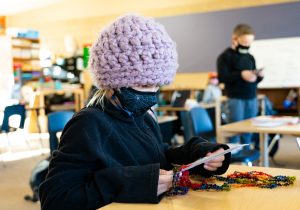
“We’ve done lots of research on the studies of transmission among the younger students, and our board decided that the transmission rates — especially of students younger than third grade — is extremely low,” said Katarina Houser, principal educator of the lower elementary school.
Students in the upper elementary [grades four to six] and the middle school [grades seven and eight], are all learning virtually from here, except for around 15 kids each day who cannot be supervised at home.
These older kids spend most of the day at desks working diligently digitally, hooked up with headphones to their laptops. This “safe space” was originally outside on
picnic tables with plexiglass dividers, but has been moved to the middle school classroom due to the colder temperatures.
“The older students definitely can handle it a little easier,” Houser said of all-virtual learning. “The younger students struggled when we were all online, and families struggled when we were all online.”
Teachers struggled at first, too. Montessori is known for its strong focus on learning through hands-on exploration, with some Montessori schools banning technology alltogether. Before this year, the extent of computer use for the younger students at SCS was typing classes for 30 minutes each week.
“Everything was in the classroom. Everything was hands-on materials.” Houser said. “I tend to be as technology free as possible, and so this was a huge adjustment for me.
“We had to learn all of [the online platforms] and then teach it to our students. Now we have students in the classroom, but we also have students online. So our program is mirrored in an online format. Every class that we do here in the classroom has the same lesson pre-recorded for our students at home.”
“So this morning, Ms. Haley [Seiber] continued our lessons on Kwanzaa,” Houser said on Wednesday, Dec. 9. “She taught how to weave the mkeka, and yesterday she pre-recorded that lesson and it posted this morning for all of our students online.
“So they’re watching a video of their own teacher, teaching the same lesson, and then if they have questions or need help they’ll email Haley.”
Houser also has a livestream session with all the students from 9 to 9:30 a.m. each morning. The school invested in laptops for each student this year, which they all used when the school was required to start virtual-only in August. Students also now use Khan Academy programs on laptops in the classroom to supplement their learning, which means less sharing of the Montessori materials between the children.
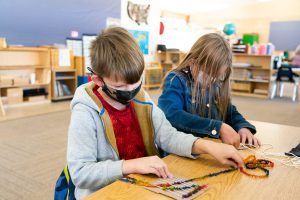
Houser said the consensus among the teachers is that they prefer being in the classroom, but the kids’ views are mixed.
“We actually did several writing projects about their preferred method of learning, because some students do enjoy learning at home and some students prefer being in the classroom,” she said. “Students said that at home they felt that they could finish more of their work — get more completed — and I think that’s because in the classroom there’s more distractions.
“You know, we pull out for violin lessons, we have our snack breaks, of course there’s the draw of social interaction which distracts students — and then at home I think they’re able to focus easier. So they liked that. But then when they were at home they said they missed their peers, they missed playing, they missed being in the classroom with the teachers. They missed the materials.”
Socially-distanced games, sitting in spaced-out circles for their lunches and of course masks are just some small prices to pay for going to school in person.
“I think there are some questions and discomfort, but we try to empathize with them,” Houser said, noting the masks. “We know it’s hard; we find it difficult as well, and its weird and new, but we learn together and I think that’s really important. And we all learn how to deal with difficult times and be part of our community.
“Montessori is all about being stewards of our community, helping out community, thinking of each other and not just ourselves and so this pandemic has been really helpful for Montessorians because we practice that every day.”
The changes have been working, with just one COVID case reported from the school so far, a student who was asymptomatic in November. However, precautions have been significant, with the school’s historic log cabin transformed into an “isolation room” with cots and full PPE gear for those exhibiting symptoms, ultraviolet light disinfection in the classroom, hiring a facilities manager who cleans daily and more.
“I just talked to Carole Lewis yesterday from the Yavapai County Community Health Services and she told me that she is using our school as a perfect example of a school that has checked all of the boxes as far as precautions and implementation of COVID safety measures,” said Crystal Hoyle, the school’s new executive director. “She was saying that most schools do some of these implementations but not all of them. And we’ve done all of them.”
However, the unexpected necessary additions have been pricey. Hoyle is hoping to hit the school’s fundraising goal of $50,000 by the end of the year. You can donate here: secure.qgiv.com/for/scrf, and found out how to direct your Arizona tax credit to them here: sedonacharterschool.com/support-scs/arizona-state-tax-credit.


